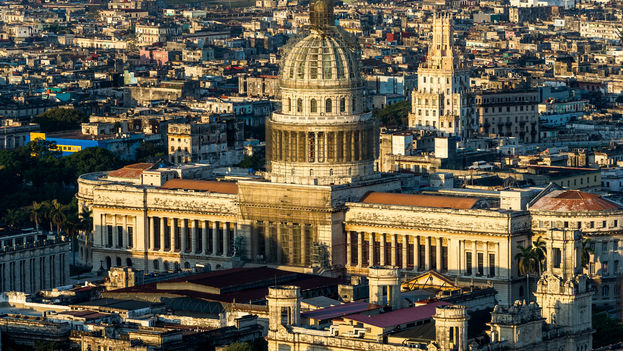
![]() 14ymedio, Pedro Campos, Havana, 27 June 2016 — Recently, Havana has been declared a New7Wonder City of the Modern World, based on the votes of thousands of people in a contest by the Swiss foundation New7Wonders, citing its “mythical attraction, the warm and welcoming atmosphere and the charm and gaiety of its inhabitants.”
14ymedio, Pedro Campos, Havana, 27 June 2016 — Recently, Havana has been declared a New7Wonder City of the Modern World, based on the votes of thousands of people in a contest by the Swiss foundation New7Wonders, citing its “mythical attraction, the warm and welcoming atmosphere and the charm and gaiety of its inhabitants.”
Winning the honor, given the palpable deterioration of the city, has kicked up a bit of scandal with protests from those who believe that Havana does not deserve such a title because of the amount of trash, debris, destroyed buildings, potholed streets, and shattered sidewalks where there are drunk people lying on every corner.
All this, along with economic backwardness and socio-cultural disaster that has been brought to us by more than half a century of populist authoritarianism, have not been able to bury the splendor of Havana’s exquisite and eclectic architecture, from earliest times to the first half of the twentieth century, the warm and welcoming atmosphere of the city and the traditionally friendly, attractive and cheerful characteristics of its population.
No, it has not been possible. Neither abandonment of the capital by the all-powerful state, occupied with survival, nor so much filth dropped or thrown on Havana could hide El Morro and La Cabaña, or conceal the intact Malecón, the Paseo del Prado with its lions, 23rd Street known as La Rampa, Paseo, G and 5th Avenue with its green areas and benches made for love, the still fabulous tunnels of Linea and 5th Avenue, or the entrance of the bay.
No amount of contempt could tarnish the luster and lineage of Central Park, or the monuments to Marti, Maximo Gomez, Maceo and Jose Miguel Gomez. Still shining in all their splendor are the Capitol building, the Government Palace, the Palace of Fine Arts, Aldama Palace and the Asturian Center.
Still standing today are the magnificence of the Hotel Nacional, the Hilton Hotel – now the Habana Libre – the Riviera Hotel, and the majestic and unsurpassed Focsa building and the Civic Square complex, just to mention signature buildings, along with the old and historic Havana Cathedral.
The damage so-called “state socialism”has brought us has not been able to destroy this work, the wonder of Havana remains intact, as does the welcoming atmosphere offered by the charm of its multi-ethnic population with their cultural diversity, musical spirit and good cheer.
Havana was and remains a Wonder City thanks to the charm that remains from the decade of the ‘50s, with the classic and antique cars, maintained and embellished by popular initiative, which present us with a city that moves slowly, as if frozen in time; leaving us unclear whether our future never comes, or we yearn to return to the past. The greatest charm of the city is its children for whom, despite all the nonsense and inattention from the unchanging government of the last 57 years, we have done what we could to care for them bring them joy.
The wonder of Havana resisted outright the snub from a government that, only in recent years, has begun to realize that it is not Varadero but the City of La Giraldilla* that is Cuba’s greatest attraction, capable of enticing millions of tourists, and so it has begun to devote some attention and resources to the restoration of some of the city’s historic buildings, including the Capitol.
It is worth noting that the historic center of Havana was declared a World Heritage Site by UNESCO in 1982 and, thereafter, an intense and reverent restoration work was undertaken by the Office of the Historian of the City as a self-funded** project, independent of the central authorities.
Hopefully, in the future, given the interest of the military and state monopolies in exploiting the tourism potential of the city, they will continue the restoration of facades, parks, main streets and sidewalks, although without the ability to add new wonders of construction to the traditional splendor of those buildings.
But ignoring of the lesson of the New7Wonder designation, the government and military remain engaged primarily in promoting golf courses and housing complexes for millionaires that could produce some money in the medium term, but which have the effect of diminishing our already critical sources of drinking water, s, living in overcrowded conditions and carrying water in buckets, are the thousands of ordinary citizens who are the ones who continue to provide the most important part of the wonder that continues to attract tourism from all over the globe.
Translator’s notes:
*A statue of a woman, and a symbol of the city, atop the observation tower in the former governor’s house.
**That is, relying on donations from overseas.
